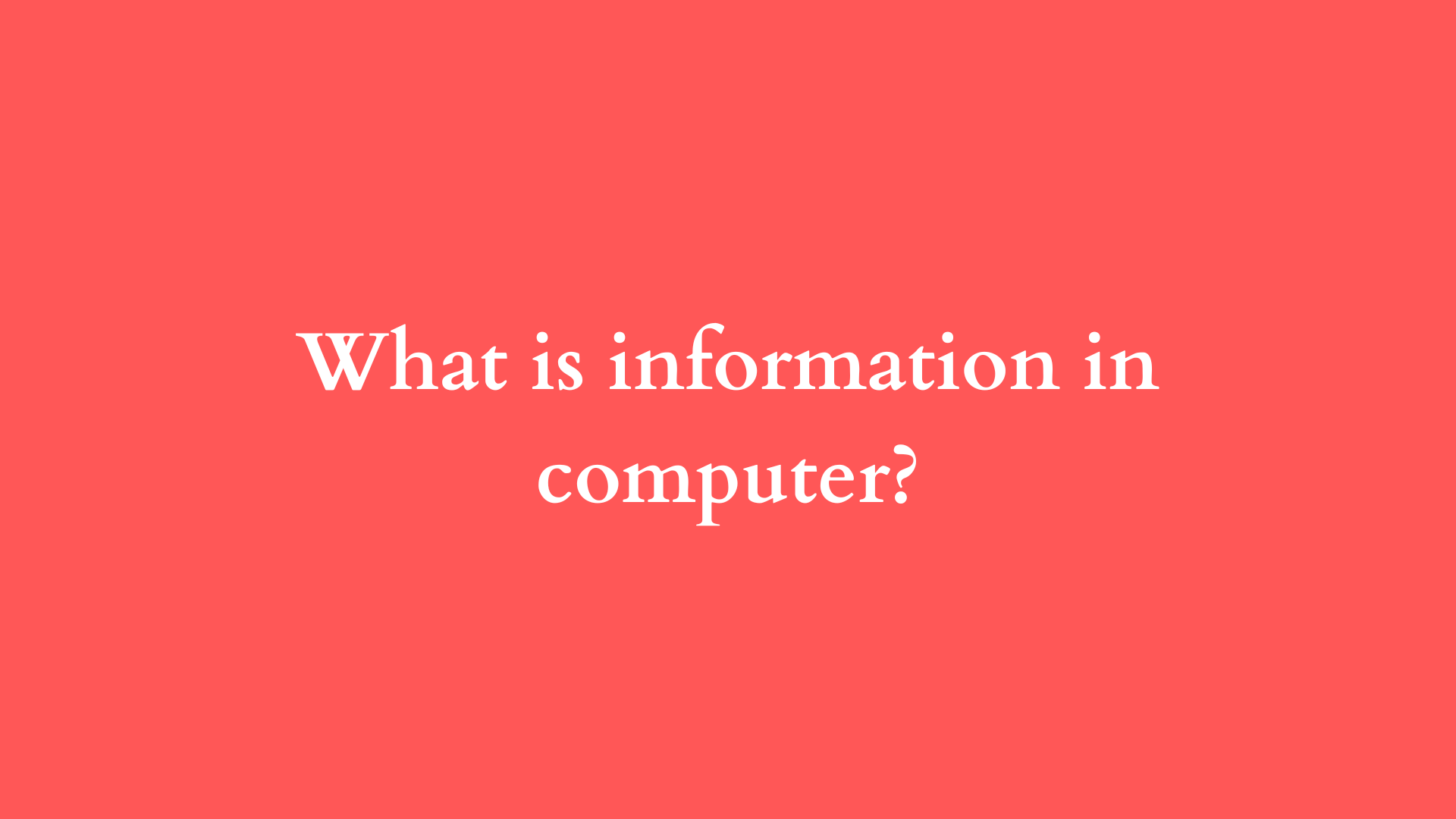Understanding Information in Computers: A Comprehensive Overview
In the contemporary digital landscape, the concept of “information” has become a cornerstone of various fields, ranging from computer science and data analysis to communications and artificial intelligence. In the realm of computers, information is not just an abstract concept; it is a fundamental entity that shapes how systems operate, how we interact with technology, and how we derive insights from collected data. This blog post aims to delve into the multifaceted nature of information in computers, exploring its definitions, types, roles in computing processes, and implications for future technological advancements.

Definition of Information
At its core, information can be defined as data that is processed or organized in a way that it becomes meaningful and useful for a specific purpose. This perspective distinguishes information from raw data, which consists of unprocessed facts and figures without inherent context. For example, the numbers “23” and “45” are mere data points until we associate them with a context (e.g., ages, temperatures, or scores). In computing, information is the output generated after data undergoes processing, such as sorting, analyzing, or formatting, which converts it into a format that is understandable and can be utilized effectively.
Types of Information in Computing
Information in computers can be categorized into different types based on its nature and representation. The following classifications are essential for understanding how computers manage and utilize information:
- Structured Information: This type of information is organized in a predefined manner, often in rows and columns akin to a database. Structured information is easily searchable and is typically managed through relational database management systems (RDBMS). Examples include spreadsheets and SQL databases.
- Unstructured Information: Unlike structured data, unstructured information does not follow a specific format and can include various types of data such as text documents, images, videos, and web pages. Analyzing unstructured information poses challenges, as it requires advanced techniques such as natural language processing (NLP) and machine learning algorithms to extract meaningful insights.
- Semi-Structured Information: This category bridges the gap between structured and unstructured data. Semi-structured information possesses organizational properties that make it easier to analyze compared to unstructured data, yet lacks a rigid structure. Examples include XML files and JSON data, which provide some level of tagging and hierarchy.
- Metadata: Metadata is often referred to as “data about data.” It is crucial in helping computers and users understand the origin, context, and characteristics of data. For instance, a photograph may have metadata associated with its date and time of capture, camera settings, and location.
The Role of Information in Computing Processes
Information plays several vital roles in the computing process. These roles are integral to the functioning of systems and applications, enabling innovative solutions and enhancing user experiences. Key roles include:
- Data Storage and Retrieval: Computers are designed to store vast amounts of information and allow for rapid retrieval based on user queries. Information is stored in various data structures, enabling efficient organization and quick access to required data.
- Processing and Analysis: The ability to process information is at the heart of computer operations. Computers utilize algorithms to transform input data into meaningful output. For instance, complex data analytics often involves statistical analysis, data mining, and machine learning—methods that rely on processing large sets of information to reveal trends, patterns, and predictions.
- Communication: Information enables communication between systems, users, and devices. Networking protocols and formats ensure that data is shared effectively across platforms, allowing for a seamless exchange of information over the internet and other communication channels.
- Decision Making: Information empowers informed decision-making, both for users and automated systems. By analyzing data, organizations can draw actionable insights, leading to improved strategies and innovations. Business intelligence tools leverage information to visualize and report on key performance indicators (KPIs), enhancing organizational transparency and strategic planning.
- Automation and Control: In the era of the Internet of Things (IoT), information is essential for the automation and control of connected devices. Sensors collect data regarding environmental conditions, user interactions, and operational metrics, which is then utilized to make real-time adjustments and optimizations.
Challenges in Managing Information
While the role of information in computers is instrumental, managing it effectively brings forth a series of challenges:
- Data Security and Privacy: As information often involves sensitive data, ensuring its security and privacy is critical. Cybersecurity threats pose significant risks, necessitating reliable security measures to protect information from unauthorized access or breaches.
- Data Quality: The efficacy of information-based decision-making is heavily reliant on data quality. Inaccurate, outdated, or incomplete data can lead to flawed insights, making it imperative to implement robust data governance frameworks.
- Information Overload: With the exponential growth of information available today, users and organizations often grapple with information overload. The challenge lies in filtering, prioritizing, and deriving actionable insights from the deluge of data.
- Interoperability: As technology evolves, ensuring that different systems and applications can communicate and share information effectively remains a challenge. Interoperability issues can hinder collaboration and data exchange across platforms.
The Future of Information in Computing
As we move further into the realm of advanced technologies, such as artificial intelligence (AI), machine learning (ML), and big data analytics, the definition and use of information in computing will continue to evolve. The future promises greater integration and automation; systems will become increasingly capable of processing and interpreting vast amounts of information with minimal human intervention.
Moreover, as data privacy regulations become more stringent globally, the emphasis on responsible data management practices will strengthen. Organizations will need to balance leveraging information for competitive advantage while ensuring compliance with evolving legal frameworks.
Conclusion
In summary, information in computers is a multifaceted entity that underpins the functionality of modern technology. From its classification as structured, unstructured, semi-structured, or metadata, to its critical roles in storage, processing, communication, decision-making, and automation, the significance of information cannot be understated. As the digital landscape evolves, understanding the complexities and implications of managing this information will remain essential for businesses, technologists, and users alike, paving the way for innovative solutions and responsible data stewardship in the future.
Shop Now






